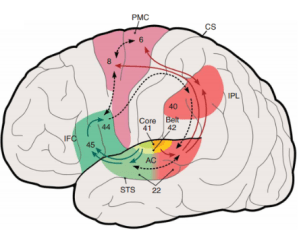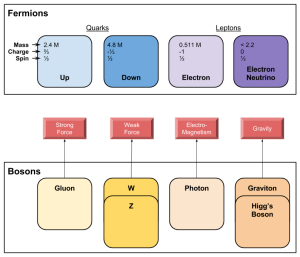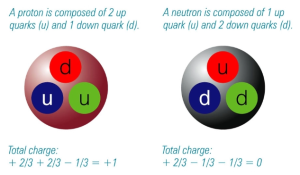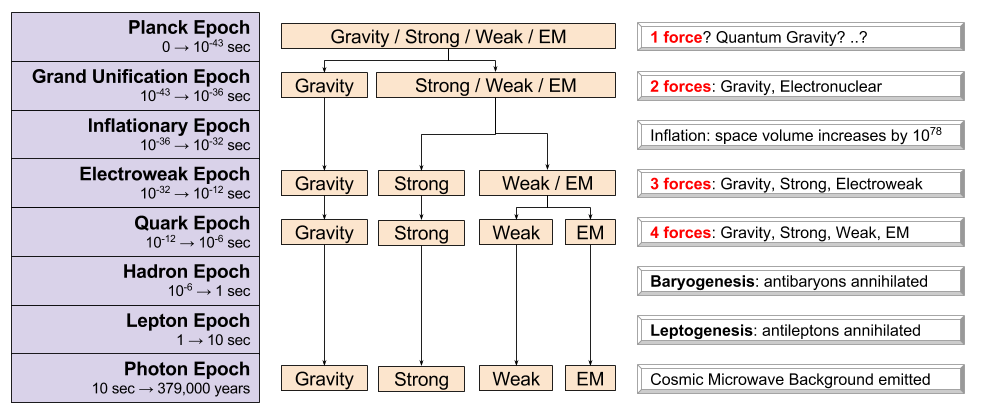Part Of: Demystifying Physics sequence
Content Summary: 1200 words, 12 min reading time.
Our lifespan is 80 years. Our consciousness refreshes every 300 milliseconds. Timespans beyond these, human brains are not well-equipped to conceive. Nevertheless, to learn the origin story of the universe, we must stare into the abyss of deep time.
Where do we come from?
Poets, philosophers and theologians have explored this question for millennia, in part seeking to ascribe meaning to the cosmos. Only recently have we discovered a literal answer, which constrains and complements our narratives.
Here are the facts.
Particle Physics
The universe is built from fermions and bosons.
Fermions are the bedrock of matter, the “meat” in our particle soup. They come in two flavors: quarks and leptons. You’ve heard of antimatter, yes? This term refers to antiquarks and antileptons.
In contrast, bosons are force carriers; the “broth” of the soup. They mediate the four fundamental forces: gravity, the strong force (which holds atoms together), the weak force (radioactivity), and electromagnetism (literally everything else).
Here are the most significant species of particles:
Protons & neutrons are not elementary particles. They are coalitions! Gluons combine quarks into groups called hadrons. When hadrons contain three quarks, they are called baryons.
Hydrogen is one electron orbiting one proton; that is, one lepton orbiting three quarks!
The Primordial Era
13.8 billion years ago, the Big Bang happened. At that moment, a gravitational singularity (the primeval atom) exploded, and became the basis of all matter, energy, space and time.
- What happened before the Big Bang? This question is incoherent: it reduces to “what happened before time existed”?
- What happened after the Big Bang? To answer this, let us divide time into eight segments.
1. Planck Epoch (0 → 10-43 sec). The climate of this period of history is so intense, known laws of physics break down. We suspect that gravity merges with the other forces, but we do not yet possess a theory of quantum gravity. Only with such a Theory of Everything can we hope to better understand what caused the Big Bang.
2. Grand Unification Epoch (10-43 → 10-36 sec). Science recovers its ability to describe nature during this epoch. The Strong, Weak, and Electromagnetic Forces exist as a single entity: the electronuclear force. The universe is expanding, but it is still a small, hot ball of plasma. Physical characteristics like mass, charge, etc are completely meaningless.
3. Inflationary Epoch (10-36 → 10-32 sec). Next, the mysterious phenomenon of cosmic inflation obtained. The fabric of spacetime explodes at a rate that far, far exceeds the speed of light. The volume of the universe expands at least seventy-eight orders of magnitude (1078 times bigger).
Few people realize the implications of such an overpowered process. Have you heard the phrase observable universe? Buried within this phrase is the implication of unobservable universes. You don’t need to wander into QM interpretations to encounter Many Worlds. We already know that there are myriad universes that we can never access: inflation simply pushed them beyond any distance our radio signals could traverse.
4. Electroweak Epoch (10-32 → 10-12 sec). At the end of this epoch, the universe has cooled enough for the Strong force to dissociate from the Electroweak force. Quarks, antiquarks, and gluons dominate the cosmos.
5. Quark Epoch (10-12 → 10-6 sec). Despite the newly independent Strong force, quarks are unable to combine. Ambient temperature is too hot, preventing nuclear fusion.
6, 7. Hadron Epoch, and Lepton Epoch (10-6 → 10 sec) . Things have finally cooled enough for quarks and antiquarks to combine! The universe fills with hadrons (e.g., protons) and anti-hadrons (e.g., anti-protons).
In this era, matter slightly outnumbered antimatter, for reasons we don’t yet understand.
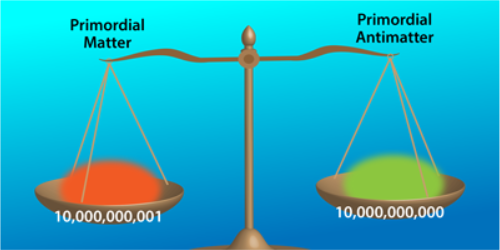
Antimatter was suppressed during these epochs. At the end of the Hadron Epoch, most hadrons and anti-hadrons experience annihilation reactions. The few survivors were matter: this is baryogenesis (baryons are a species of hadron).
In the subsequent Lepton Epoch, leptons and anti-leptons (e.g., electrons and anti-electrons) also annihilate one another en masse. Antimatter was again underrepresented in the survivors: this is leptogenesis.
8. Photon Epoch (10 sec → 380,000 years). 10 seconds after the big bang, and photons dominate the universe. Protons and electrons (hadrons and leptons) exist, but are unable to come together due to high temperatures. The free electrons scatter light: photon travel is randomized by collisions with free electrons, in a process known as Compton scattering.
As the fabric of spacetime continues to expand, two other things happen:
- Recombination: Temperatures drop to a point where electrons and protons could come together to form hydrogen atoms!
- Rise of the Fermions: The expansion of space stretches photon wavelength, decreasing its total energy content. Fermions, whose populations had been decimated in the destruction of antimatter (c.f. baryogenesis and leptogenesis), reclaim the title as the most energetic substance in the universe.
The eventual result was photon decoupling. Temperature finally permits light could travel freely. The universe becomes transparent.
You’ve probably heard that it takes light from the Sun eight minutes to reach Earth. If the Sun suddenly disappeared, we would only learn that fact eight minutes later. Similarly, if a star 40,000 light-years away suddenly explodes in a supernova, we must wait until 42,016 AD to learn about that. Starlight is a form of time-travel.
What are the oldest photons we can see? How far back into our past can we peer?
Well, we can see galaxies being formed 200 million years after the Big Bang. And we can peer back farther still. We can directly see light emitted the moment the universe became transparent; this is the Cosmic Microwave Background (CMB).
Why is the CMB not smooth? The ripples are microscopic phenomena writ large: inflation exploded quantum fluctuations on a cosmic scale…
Some of the static in TV antenna is caused by the CMB. You can literally see evidence of the Big Bang with your own eyes.
Structure Formation
Photon decoupling has ensured that light can travel freely in a sea of hydrogen. However, there were no stars at this point: the CMB is the only light source. This is the Dark Age of the universe, a time before stars.
Why is so much of space a vacuum?
In the Inflationary Epoch, inflation etched ripples into the energy distribution of the cosmos. Gravity accentuates this heterogeneity by pulling matter together. Space is mostly empty because particles like to spend time together.
Gravity appears to operate at three different spatial frequencies.
- Very large clumps of hydrogen become superclusters.
- Within every supercluster, there are billions of smaller clumps called galaxies.
- Galaxies in turn comprise billions of smaller assemblies: stars and solar systems
The origin of all things is the hydrogen cloud, and gravitational attraction.
Takeaways
- There are two kinds of particles in the universe: fermions (“matter particles”) and bosons (“force particles”)
- The Big Bang happened 13.8 billion years ago. The early universe was hot, and expanded quickly.
- Three important events in occur in the first second of the universe
- Cosmic Inflation: the fabric of the universe stretched much faster than the speed of light, creating unobservable universes.
- Force Differentiation: the four forces (gravity, strong, weak, electromagnetic) separated from one another
- Fermion Asymmetry: antimatter was preferentially annihilated
- Afterwards, the universe was replete with clouds of hydrogen. Gravity pulled these together to form stars, galaxies, and superclusters.
